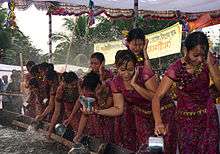Marma people
| မရမာ | |
|---|---|
 Marma Dance | |
| Total population | |
| 210,000 | |
| Regions with significant populations | |
| 157,301 | |
| Unknown | |
| Unknown | |
| Languages | |
| Arakanese language | |
| Religion | |
| Theravada Buddhism | |
| Related ethnic groups | |
| Rakhine people | |
|
one of the 135 officially recognized ethnicities in Myanmar (formerly Burma) | |

Marma (Burmese: မရမာလူမျိုး) is the second largest ethnic community in Chittagong Hill Tracts (CHT). They moved Bangladesh from Arakan State in AD 17 century. They living in the three hill districts of Bandarban, Khagrachari and Rangamati. Some are living in the coastal districts of Cox's Bazar and Patuakhali. They are sometimes referred as Mogh/Magh and were known by that term for centuries until the late 1940s. Marma Peoples are over 210,000 Population just within Bangladesh. In the 16th century the Kingdom of Bohmong and Mong was established by themselves in the Bengal. Since then, Chittagong Hill Tracts (CHT) is their home.
History
There are two opinions holding on the lineage of Marma. Historically Marma is descendants of Arakanese while Bohmang family claimed the linage of Mon of Burmese. However the records of East India Company and others provide that Marmas migrated from Arakan kingdom of Burma to the Chittagong of Bangladesh in two phases of migrations during 14th to 17th centuries in the golden period of Mrauk U. In the first phase during the Mrauk U period Arakanese kingdom was expanded to even some parts of Chittagong Division. Secondly, they fled to Chittagong and settled down as the Arakanese kingdom was conquered and tortured by the Burmese king Bodawpaya. The Bohmang family might be descendant of Mon of Pegu but not the Marma or Magh.
1. According to some the term “Marma” derived from the term “Myanmar”. As there is another claim that Marmas are originally linage of Peguan/Mon and Burmese. So the term Marma was officially coined by Bohmong Maung Shwe Prue in the late 1940s to people of his circle because the king was the descendant of Myanmar. The word of Myanmar changed phonetically as it is pronounced differently by Arakanese and Marma. Sometimes Arakanese pronounces “Ya” of Burmese pronunciation in “Ra” phones. For example, Arakanese pronounces “Rangoon” for “Yangoon” of Burmese. So this is similar to above example of phonetic changes. He wanted to write Mranma (which is Myanmar) unfortunately it was eventually spelled Marma.
2. Another assumption is that the term “Marma” derived from the Chinese word “Meing” which means man. It denotes to call the people of Burma by the Chinese.
They were known as Mogh/Magh for centuries because they were called Mogh/Magh by Bengali for joining hands with Dutch and Portuguese pirates during their invasion in Chittagong. In latter period they do not want to be called by it. They felt offensive and insulting, because it means pirate. Therefore, picking up new name Marma was necessary for people in Bangladesh while others in Tripura state of India kept the same name as Mogh/Magh. They have their own good reasons and they do not consider Mogh/Magh as offensive term but Mog/Magh as rulers and descendant of Magadhi. However they are not identified two from Marma in Bangladesh and Mogh in India.
Culture
They follow the Burmese calendar. They celebrate new year called Sangrai.[1] Marma community celebrate in three parts starting on the first day of Baishakh. They make 'Sangraimu' which is a form of traditional cakes. The take part in Pani Khela where young marma men and women spray each other with water. On the 2nd day called Sangrai Aika they participate in traditional sports and hold meeting regarding community issues. On the 3rd day called Sangrai Atada they cook a vegetable dish made out of more than 100 ingredients called Pagan.[2]
See also
References
- ↑ Barua, Sanjoy; Khan, Tamanna. "Blaze of 'Boisabi' colour". thedailystar.net. The Daily Star. Retrieved 1 July 2015.
- ↑ Correspondent. "Hill districts wear a festive look as Boisabi nears". archive.thedailystar.net. The Daily Star. Retrieved 1 July 2015.
External links
- Ethnologue profile
- Photographs of the Marma people
- Khan, Sadat Ullah (2012). "Marma, The". In Islam, Sirajul; Jamal, Ahmed A. Banglapedia: National Encyclopedia of Bangladesh (Second ed.). Asiatic Society of Bangladesh.